“Flying Dinosaurs”
Posted by: Loren Coleman on February 20th, 2006
Two new publications have appeared on the little-discussed subject of what is popularly referred to as "flying dinosaurs." These two works, however, are at separate ends of the cryptozoology continuum.
One is a non-fiction review of the sightings over North America of pterodactyl-like creatures, and the other is a comic graphic novel. Intriguingly, their promotional imagery is reminiscent of each other.

In Volume 10, Number 2 of the journal Wonders, cryptozoologist and the journal’s editor Mark A. Hall tackles living dinosaurs, first in an article about ones that soar. The flying variety over his home continent are detailed. Also Hall writes of "other beasts resembling dinosaurs" that are reported around the globe, "including a carnosaur to rival anything in the movies."
Mark A. Hall has been writing about mysterious natural phenomena for over thirty years. Since 1992, his journal Wonders has covered many mysteries in the fields of cryptozoology, anthropology, and the uncharted world of forteana. Additionally, his books have contained ground-breaking theories, intriguing conclusions, and often forgotten, overlooked evidence for cryptozoologists and hominologists to ponder. Hall’s past work on Thunderbirds is well-known, and this new contribution on "flying dinosaurs" extends his view of what’s occurring in the sky.
Now, in a weird twist of fate, comes word of another new work on “flying dinosaurs.” But will the arrival of a graphic funny novel muddle two threads of inquiry that non-fiction cryptozoologists have always tried to unravel?
In 2005, Cryptozoo Crew author Allan Gross decided to do a little background research for his forthcoming story. He traveled to Alaska, as he says in his press release, "to find the hidden truth behind the legends and sightings of the mythical Thunderbird, often considered to be a surviving flying dinosaur." Ooops, did he say "Thunderbird" = "surviving flying dinosaur"?

Be prepared for a wild ride in the world of the Cryptozoo Crew’s newest book-length comic, Call of the Thunderbird.
The graphic novel is a comixture of Thunderbird lore and phrasology with flying dinosaurs. I suppose this is okay because it is a totally humorous fictional treatment, but I think it does not assist understanding what’s going on out there in the field. Or in the skies.
The confusion that occurs when the word "Thunderbirds," which traditionally has been about giant birds, is employed to label pterodactyl-like flying reptiles, is unfortunate. Nevertheless, it’s cryptofiction, it’s more strange theories that have little or no reality to them, from the minds of writer Allan Gross and artist Jerry Carr. We sometimes, I guess, in cryptozoology, have to suspend critical reality for a laugh or two. Apparently. 🙂

The Call of the Thunderbird is a story about the origins of the cryptozoo hero, Tork, according to artist Jerry Carr, who enjoyed drawing the youthful, colorful Tork as a child in this 2006 graphic novel. Unlike the Gross and Carr first book, which was a collection of short satiric stories, this one is a more indepth, full length adventure. For a humorous break, and more about the Cryptozoo Crew’s work, visit their website.
For a flight back into reality, Mark A. Hall’s book, Thunderbirds: America’s Living Legends of Giant Birds is highly recommended for an overview of the genuine story behind flying teratorns, Bighoot, Mothman, and other giant birds in the US, Canada, and around the world.
About Loren Coleman
Loren Coleman is one of the world’s leading cryptozoologists, some say “the” leading living cryptozoologist. Certainly, he is acknowledged as the current living American researcher and writer who has most popularized cryptozoology in the late 20th and early 21st centuries.
Starting his fieldwork and investigations in 1960, after traveling and trekking extensively in pursuit of cryptozoological mysteries, Coleman began writing to share his experiences in 1969. An honorary member of Ivan T. Sanderson’s Society for the Investigation of the Unexplained in the 1970s, Coleman has been bestowed with similar honorary memberships of the North Idaho College Cryptozoology Club in 1983, and in subsequent years, that of the British Columbia Scientific Cryptozoology Club, CryptoSafari International, and other international organizations. He was also a Life Member and Benefactor of the International Society of Cryptozoology (now-defunct).
Loren Coleman’s daily blog, as a member of the Cryptomundo Team, served as an ongoing avenue of communication for the ever-growing body of cryptozoo news from 2005 through 2013. He returned as an infrequent contributor beginning Halloween week of 2015.
Coleman is the founder in 2003, and current director of the International Cryptozoology Museum in Portland, Maine.










The only flying dinosaurs are BIRDS! “Pterodactyls”, more properly known as pterosaurs, are NOT DINOSAURS!
Sheesh
Yep, that’s why “flying dinosaurs” is a phrase placed in quotation marks. 🙂
And it is a double-barreled pun, too, with all the talk of Thunderbirds (as opposed to quails) here.
Enjoy.
I am currently wrapping up a book about the Big Bird of Texas, which was described by many as being a “flying dinosaur”. In it, I’ve included many new and unpublished accounts of living pterosaurs. If anyone has heard of a modern sighting or has anything else to share in this vein, I would be very interested to hear about it.
The most compelling theory for the “Big Bird” sightings of Texas was that they were of a large bat, perhaps even a cryptid bat.
That is indeed a compelling theory. However, in going over eyewitness descriptions of Big Bird, the words “pterosaur or pterodactyl” come up quite frequently, at least a dozen times. The word “bat” is rarely used by witnesses, unless they are attempting to describe the wings. Also, there are no bats in the fossil record that anywhere appoach the fifteen to twenty-foot wingspan that is usually reported.
Eyewitness descriptions have no relationship to “what” a cryptid might really be. In other words, the fantastic notion that one says they see a pterosaur does not mean that a person has actually viewed a pterosaur.
People see pterodactyls as the source of leathery-winged weirdie encounters because they are conditioned to expect “flying dinos” from the movies.
Furthermore, eyewitness credibility with measures of things seen in the sky is lacking. The wingspan of the flying fox (Pteropus sp.) is 6.5 feet, but might appear to be twice or more that wide by a scared eyewitness.
Also, of course, all that exists in nature has not as yet been found in the fossil record.
That’s right, because many species leave no imprint on the fossil record because fossilization is basically “luck of the draw.” This leads to the existance of “ghost lineages” like the coelacanth, making the anti-living dino argument of “They went extinct” fairly lame, because, unless we can monitor every square inch of the earth at the same time 24/7, we can’t prove they aren’t still alive.